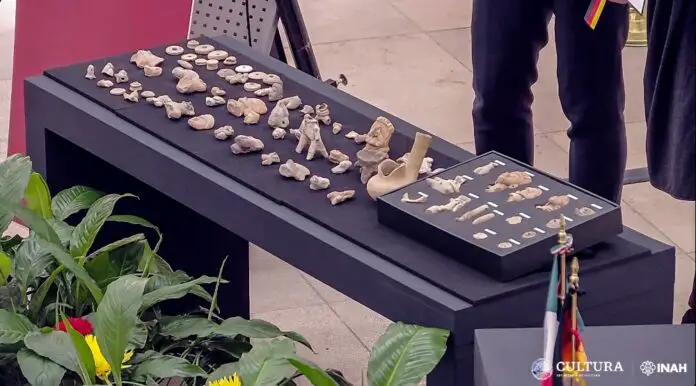Berlin, Ale.- As another example of the multilateral collaboration between Mexico and Germany, this November 23, 2023, 75 archaeological pieces, mostly linked to the Huasteca culture, were returned through the Mexican Embassy in that country .
The delivery-reception ceremony, held at the Representation facilities, was led by the ambassador of Mexico in Germany, Francisco Quiroga Fernández, as well as by the deputy director general of Culture and Society of the Federal Ministry of Foreign Affairs of Germany, Stefan Rössel. At the ceremony, the sensitivity of German society to join forces and prevent trafficking, exhibition and illegal trade of cultural goods was recognized.
“Having these archaeological pieces as souvenirs or decorative items constitutes an insult to the native peoples. Hence, its restitution not only guarantees its preservation and study, but also returns to our indigenous communities a fundamental part of their historical memory,” declared Ambassador Quiroga Fernández.
In this sense, through a virtual link, the Secretary of Culture of the Government of Mexico, Alejandra Frausto Guerrero, pointed out that this return, through which the 13,422 archaeological pieces returned to our country, in the administration of the President Andrés Manuel López Obrador, “is the result of extraordinary efforts by curators, archaeologists, diplomats, customs personnel and, in general, people who believe in bilateral relations based on understanding, respect and justice.”
He recalled that within the framework of the World Conference on Cultural Policies and Sustainable Development (Mondiacult 2022), held in our country, the States present, including Mexico and Germany, assumed the commitment to promote a new awareness around respect for places of origin of cultural heritage.
Accompanied by the general director of the National Institute of Anthropology and History (INAH), Diego Prieto Hernández, and the undersecretary of Foreign Affairs of our country, Carmen Moreno Toscano, Frausto Guerrero explained that of the 75 pieces returned to Mexico, 74 come from the Museum Schloss Salder, from the city of Salzgitter, located in the state of Lower Saxony.
In this regard, anthropologist Diego Prieto indicated that 74 objects were found 120 years ago, by a German master who was working on drilling a well in the city of Tampico, Tamaulipas, in 1900, and that they were incorporated into said museum around 1963.
Although it is not fully documented how these goods – between 500 and 2,000 years old – arrived in Germany, the city of Salzgitter and the Schloss Salder Museum took the initiative to voluntarily return them to Mexico.
The remaining piece is a stone tripod mortar, approximately 4,000 years old, confiscated at customs in the city of Leipzig, after the recipient of its postal shipment could not present to the authorities the current export certificate necessary to prove its lawful possession.
The Undersecretary of Foreign Affairs, Carmen Moreno Toscano, said: “Mexico and Germany are strategic partners that share interests and that, as responsible global actors, we maintain broad coincidences on the multilateral agenda and in the main international forums and organizations.”
The event included the participation of the head of the Office for Historical Memory of Mexico, Gabriela Pulido Llano, federal representative Dunja Kreiser, president of the Germany-Mexico Parliamentary Group in said nation, the Executive Director of Cultural and Tourism Diplomacy, Juan Patricio Riveroll; the director for the restitution of cultural heritage of the Foreign Ministry, María José Buerba, as well as the ambassadors of some countries in Latin America, Africa and the Caribbean. During the ceremony, the promotion of the #MiPatrimonioNoSeVende campaign was called, as an international example of the current change in thinking towards sensitivity and full respect for indigenous cultures.







